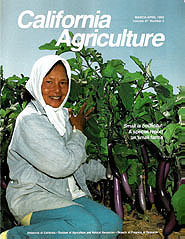All Issues

Small is bountiful: A special report on small farms.
Cover:
With the help of UC Small Farm Advisor Pedro Ilic, Fresno County farmer Chan Eagle has obtained abundant yields of Japanese eggplant – tenfold the output of some surrounding farms. She also grows oriental herbs and other specialty vegetables.
March-April 1993
Volume 47, Number 2
Volume 47, Number 2





